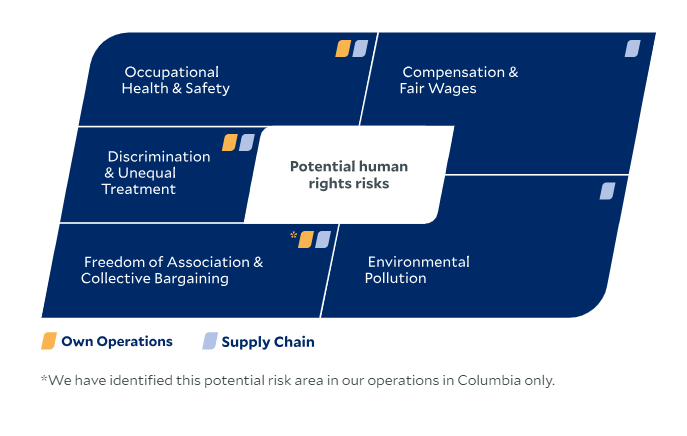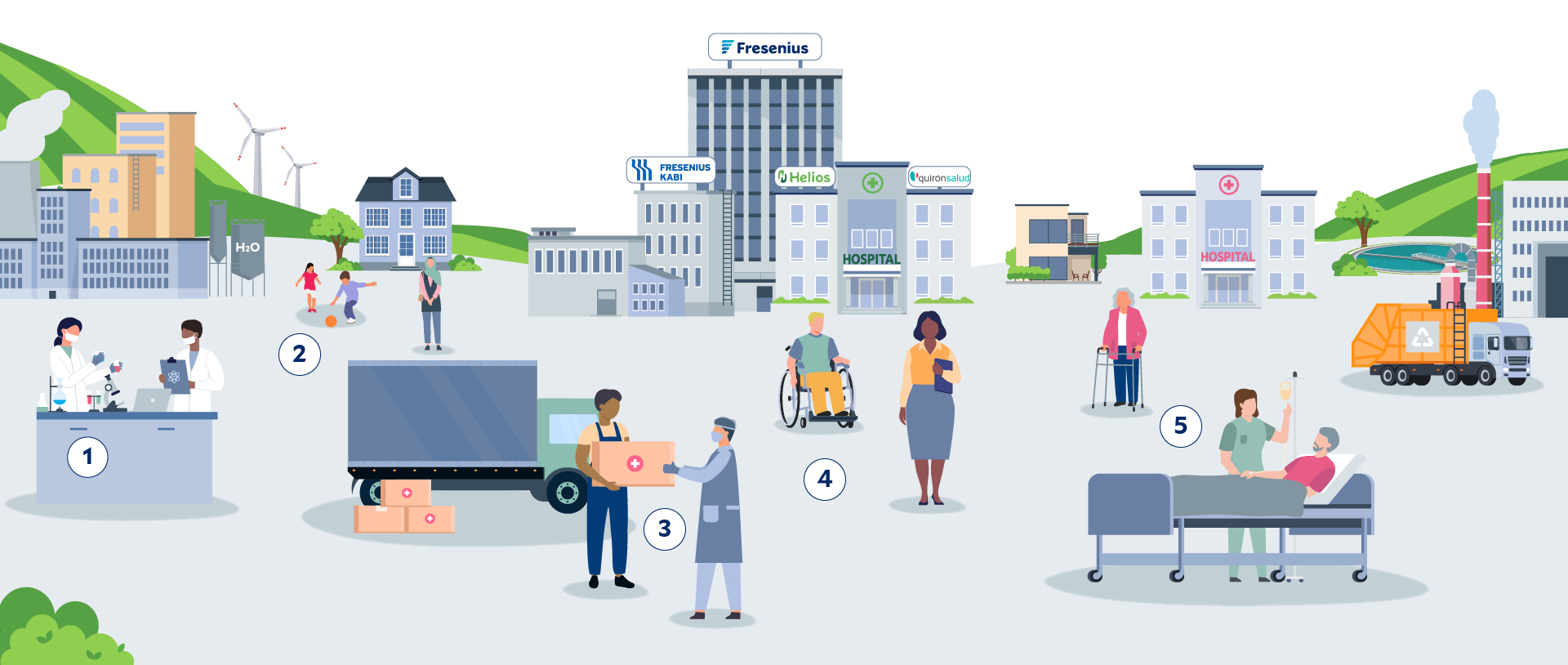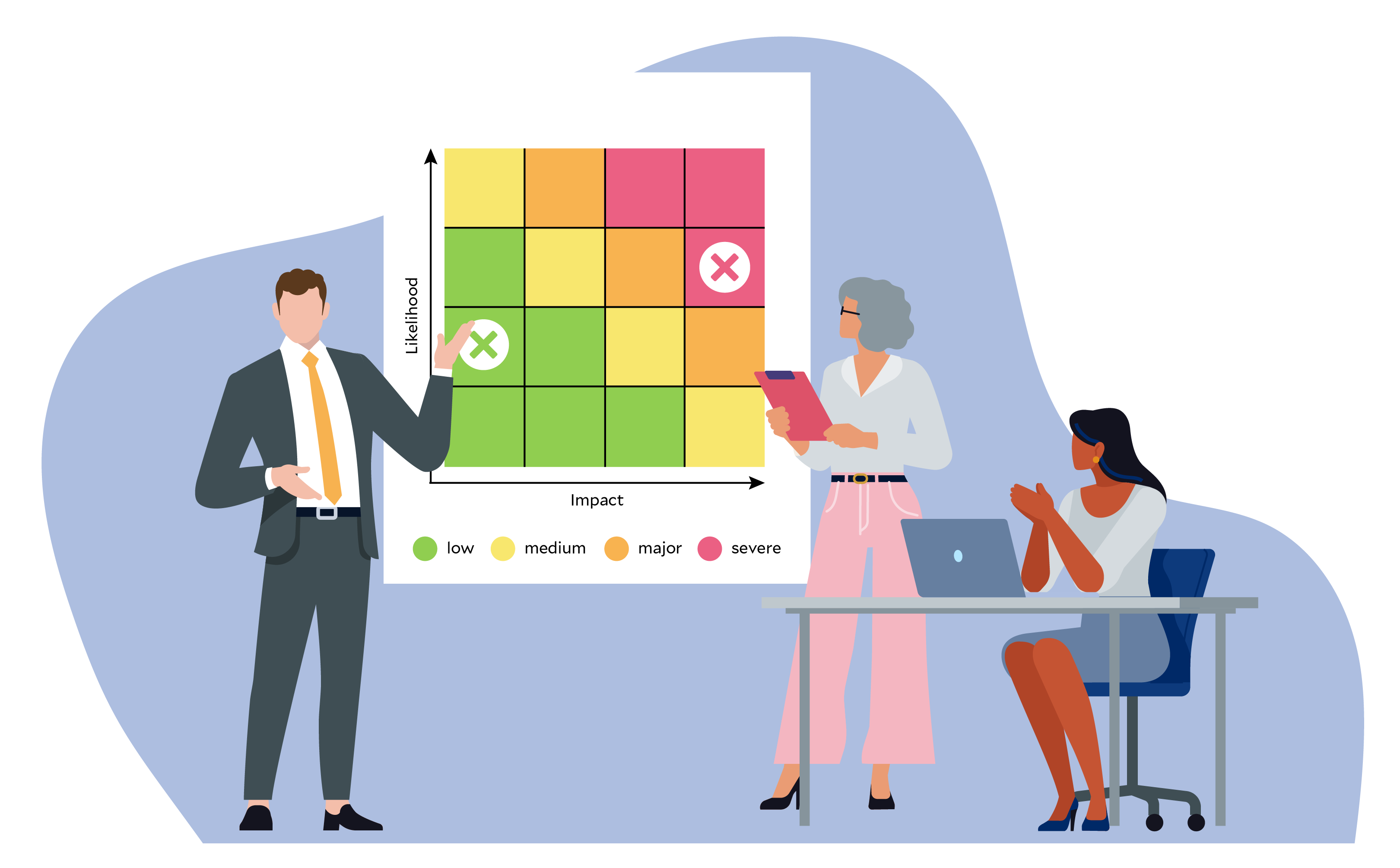Risk Assessment & Impact
Human rights risks can change over time. We therefore conduct annual and event-related risk analyses. In the 2024 reporting period, this was done in the third and fourth quarters. An event-related risk analysis was not conducted.
Process for identifying and assessing human rights risks
Identifying and assessing human rights risks in our own company and in our value chain is a comprehensive process that consists of risk identification, risk analysis, and risk assessment. We follow a risk-based approach that can be divided into three phases and is explained below with the help of the fictional protagonist, John.*
*The persons and stories depicted in these images are purely fictional. Any resemblance to actual persons is purely coincidental and unintentional.
Curious about how we weigh and prioritize risks? Here's how:
To weight and prioritize risks, we introduced a comprehensive methodology for assessing their impact and likelihood of occurring. Using this method, the risks are plotted on a matrix (4x4).
The evaluated impact on those affected ranges from “low” to “severe”. It is assessed using four evaluation criteria: scope, scale, possibility for remedial action, and company involvement.
Probability of occurrence ranges from “unlikely” to “almost certain”. It is assessed using three different evaluation criteria: process evaluation, evaluation of similar cases which have already arisen, and context factors which could increase the likelihood of the risks materializing.
Results of the risk analysis
We carry out a regular risk analysis of human rights topics for both our own businesses and our supply chains in accordance with the specific requirements of applicable international and national laws and regulations. As part of this risk analysis, we identify areas that we consider to have high priority due to the potential severity of possible violations and due to our ability to influence them.

Prioritized risk areas for own operations
The risk analysis for the 2024 reporting year confirmed the following existing prioritized risk areas for our own operations and revealed additional potential risks:
- Discrimination and unequal treatment
- Freedom of association and collective bargaining
- Occupational health and safety in the workplace
Preventive measures to mitigate risks in our own operations
As a healthcare Group, we not only bear responsibility for the well-being of our patients, but also for the health and safety of our employees. We implemented a Group Policy on Social and Labor Standards. The guideline describes our global social and labor law minimum standards. We expect our employees and managers in all business segments of the Fresenius Group to comply with this guideline without exception. Lower standards are not acceptable. Should laws or practices in countries where we operate restrict or contradict the standards set out in this policy, we will apply the policy to the extent permitted by local laws . Moreover, the Fresenius Code of Conduct stipulates that we take the necessary measures to protect our employees and prevent work-related accidents and illnesses.
Creating a safe and healthy working environment is a priority for us. When it comes to health protection, prevention is our basic principle: We therefore provide our employees with comprehensive programs to promote their health and prevent work-related illnesses. The return of employees after an illness is regulated, for example, by the company integration management system.
We have introduced numerous management systems and measures throughout the Group and adapted them to the business models of the business segments. They focus on occupational health and safety in the production area as well as occupational health management for employees in healthcare facilities or in administration.
All locations are also subject to the respective local regulations and laws. Compliance with these regulations is ensured at local level. In addition to statutory regulations, internal guidelines and directives such as management manuals and standard operating procedures also play a significant role in occupational health and safety. In addition to the Group-wide Fresenius Code of Conduct, the business segments have their own guidelines that regulate occupational health and safety, e.g. the Clinical Code of Conduct for the rehabilitation and nursing units and medical personnel in the healthcare services market segment.
The internal requirements are supplemented by corresponding internationally recognized standards for management systems such as ISO 45001 at some locations as well as other certifications in accordance with ISO or national standards. The overarching aim of the ISO 45001 management system is to continuously improve occupational health and safety management, align it with internationally recognized methods and ensure the effectiveness of existing procedures and systems. To drive this forward, we are consistently expanding the number of entities certified to this standard.
Further Information can be found in the 2024 CSRD report from page 216.
To minimize potential human rights risks connected to our business activities, we have taken further preventive and mitigating measures. These include, for example, training that we offer to our workforce. The Fresenius Group, for instance, conducts regular occupational health and safety training to prevent incidents in its fields of operation.
To sustainably promote tolerance and appreciation within our teams in the long-term and to mitigate the risk of discrimination, it furthermore is not only necessary to have a corresponding culture that is exemplified by the management bodies; employees also receive training and further education on the topic of diversity.
The elimination of discrimination is both a component of our Group-wide compliance programs and a key element of our Human Rights Program. These concepts are supplemented by suitable controls, process documentation, training concepts, awareness-raising measures, and the use of whistleblower systems. In this way, we want to ensure that discrimination, including harassment, is prevented, contained, or combated in our operational business if we become aware of violations, risks, or impacts.
Another central element is the successive roll out of a company-wide human rights training for our employees. The training aims at educating our employees on this important topic – not only about their personal human rights, but also about the contribution that everyone can make in their daily work. It further imparts knowledge about individual rights and how to deal with possible human rights violations.
In addition, we have implemented individual and local measures to provide our employees with the best possible protection within our sphere of influence. For instance, at high-risk locations, we deploy more security staff than is typically found in hospitals to better protect our employees and patients around the clock. Furthermore, a monthly committee with participants from local management and employees has been established to strengthen the dialogue.
Further details on preventive and remedial measures, as well as on appropriateness and effectiveness, are available here.
Prioritized risk areas for our value chain
The risk analysis for the 2024 reporting year confirmed the following existing prioritized risk areas for our value chain and revealed additional potential risks:
- Remuneration and appropriate compensation
- Discrimination and unequal treatment
- Environmental pollution
- Freedom of association and collective bargaining
- Occupational health and safety in the workplace
Preventive measures to mitigate risks across our value chain
To counter the potentially negative effects, we have initiated and implemented further preventive measures in addition to existing ones. With the risk-based implementation of human rights and environmental clauses in contracts, we also agree with suppliers on specific requirements for cooperation and information obligations in the event of human rights violations.
Our Code of Conduct for Business Partners also sets out fundamental expectations regarding respect for human rights. To monitor compliance with these principles and use the results to provide industry-wide support, Fresenius Kabi, for example, prepared to join the Pharmaceutical Supply Chain Initiative (PSCI) as an associate member in the reporting year (2024). In the future, the company will participate in the industry-wide audit pooling and thus contribute to greater transparency regarding working conditions and – where necessary – corresponding corrective or remedial measures in the pharmaceutical supply chain.

“Our membership in the Pharmaceutical Supply Chain Initiative reflects our commitment to shared responsibility, ethical sourcing, and collaboration — all essential to driving respect for human rights across our value chain.”
Marco Kraemer, Director Supplier Quality Management & Human Rights Function, Fresenius Kabi
To further increase transparency in our upstream and downstream processes, we also plan to further expand the existing descriptions and visualizations of our value chains and carry out focus risk analyses on this basis. Further details on preventive and remedial measures, as well as on appropriateness and effectiveness, are available here.

Human Rights at Fresenius
Our Human Rights ProgramContact
Fresenius SE & Co. KGaA
Else-Kröner-Str. 1
61352 Bad Homburg
Germany
humanrights@fresenius.com
Human Rights Program
Our Human Rights Program Group-wide Governance & Responsibilities Preventive & Remedial Action Grievance Procedure & HandlingWhistleblowing system
Reports on possible human rights or other types of compliance violations can be reported around the clock, either anonymously or by name, via our whistleblower system*:
Phone number: +49 (0) 800 181 1338*
https://freseniusgroup.ethicspoint.com
More infos about our grievance mechanism
*The prices of your mobile or landline contract apply
The reporting on the respect for human rights for the year 2024 and following can be found in our Sustainability Report (CSRD Report). Further information on Fresenius' human rights program is available here: fresenius.com/en/human-rights




